Africa Travel in 2021: Find out what to expect on an African Safari in Tanzania during the Covid-19 pandemic.
This is the story of three of our clients who travelled to Tanzania and Rwanda in May 2021. First, they went gorilla trekking in Rwanda’s Volcanoes Park and then they took a Tanzania Safari, travelling via Ethiopia. Below is what these three South African women experienced on their East African travels booked through African Budget Safaris this year.
Arriving in Tanzania
We entered Tanzania through Dar es salaam along with approximately 280 other people on board Ethiopia Airlines. Each of us anxiously clutching our passports and Covid results. The three of us were tired of planes and built-up places and super ready to take on the expanse and wide, wild open spaces promised to us from our Tanzania Experience itinerary.
As we entered the airport building, we joined the rest of the passages queuing to… “This way please, Covid test please”… Oh no! … “No, here we are, we’re negative that’s how we managed to get on the plane to get here”… “look here” resonated from everyone. Even another South African, flaunting his Lancet Lab results tried and then us “here, please see these, they are printed on Rwanda Government Official stationary and performed by a state of the arts Rwandan Laboratory” trying hard to convince them positively of our negative status.
But, it was not to be. $25 and a smear of our throats and our ‘official’ Tanzania results were presented to us on a square piece of white paper, torn out of a book, the same size of a post-it pad note with a number, your first name only and “-ve” written on it… and we were through!! Wow, we almost felt robbed, but what the hell, that was short-lived, as gratitude for our Tanzania official Covid status, quickly took over. Tanzania Experience was there to meet us and we were delivered to Meru View Lodge, set in a quiet little corner on top of a hill in Arusha town.
Tarangire Safari in Tanzania
Tarangire National Park sign
The following morning, after breakfast, Justine from Tanzania Experience met with us and briefed us on our itinerary, protocol and procedures then handed us over to Max our guide for the duration of our stay.
We travelled to Tarangire National Park, passing through towns hosting hundreds of thousands of motorcycle taxis.
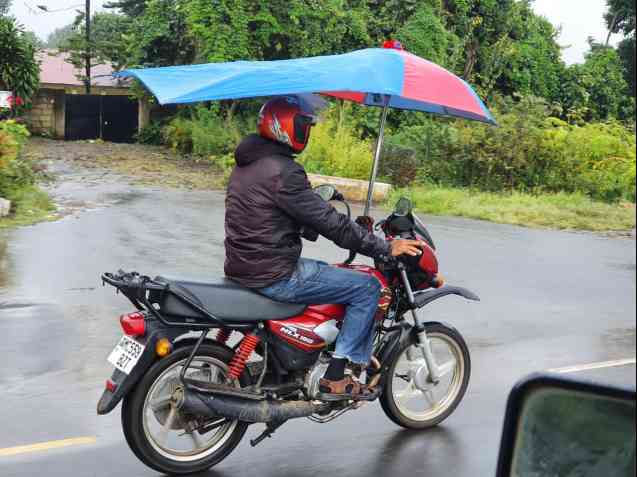 Motorbike taxis in Tanzania
Motorbike taxis in Tanzania
Max explained that many young men were unemployed and the government encouraged them to become motorcycle taxi operators. They have taken it to the limits! Most of them even have umbrellas with extensions to cover their passengers.
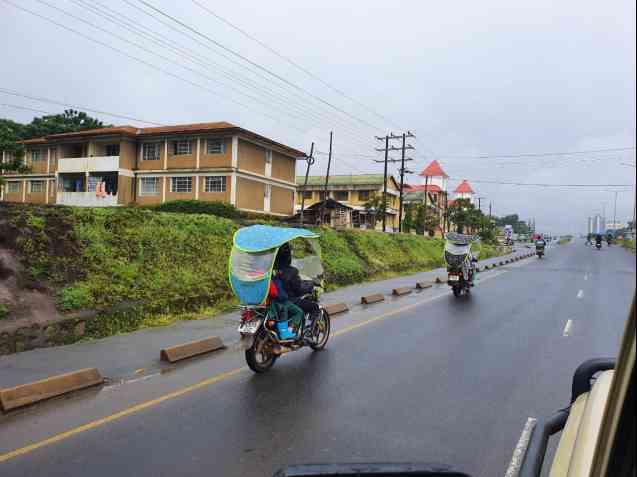 Motorcycle taxis en route to Tarangire Park
Motorcycle taxis en route to Tarangire Park
Out of the town, we started appreciating the wide and vast lands. We passed many kilometres of Maasai homelands, but more about them later. Just before we entered the park we noticed baobab trees. Max laughed and said “yes, you are now saying “look baobab” and soon you will not say anything as you will see many!” Yes, Tanzania is full of baobabs and each with its own uniqueness. In fact, Tanzania has many different trees.
 Baobab Tree en route Tarangire Safari
Baobab Tree en route Tarangire Safari
The park was lush and also wet from seasonal rain and we saw plenty of birds and game.
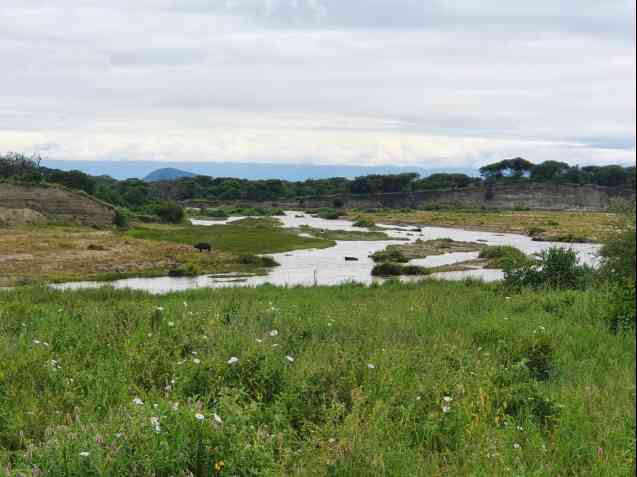 Tarangire Park scenery, Tanzania
Tarangire Park scenery, Tanzania
Lunch was a picnic at a look-out point over Tarangire river, watching elephants in the distance and secretively sharing titbits with hornbills and buffalo weavers who hadn’t seen many visitors for a while due to Covid.
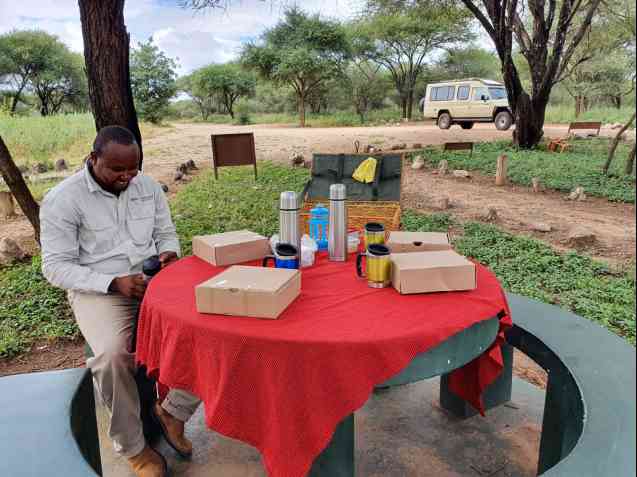 Picnic stop on Tanzania safari
Picnic stop on Tanzania safari
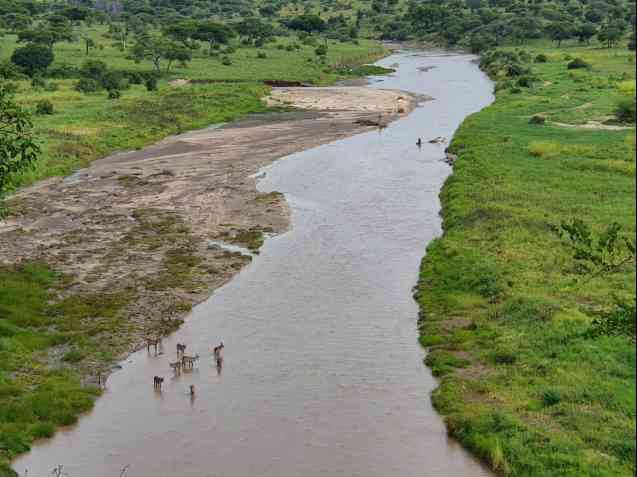 Tarangire River stop, Tanzania
Tarangire River stop, Tanzania
 Tarangire safari – birdlife
Tarangire safari – birdlife
Max our guide timed it perfectly right to move on. We headed towards where the elephants were and parked close by. It wasn’t long before they started moving. They passed the vehicle so closely (could have stretched out my hand and touched them) in front and behind barely looking at us, ignoring the clicking of our cameras but fully aware of our presence.
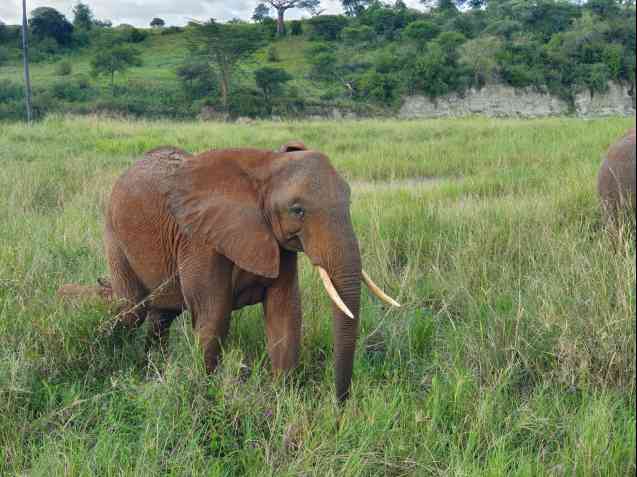 Tarangire Safari – elephant
Tarangire Safari – elephant
 Tanzania Safari – elephants in Tarangire
Tanzania Safari – elephants in Tarangire
We moved onto a massive baobab tree in the middle of the park. The centre is hollow and big enough to hold 12 men.
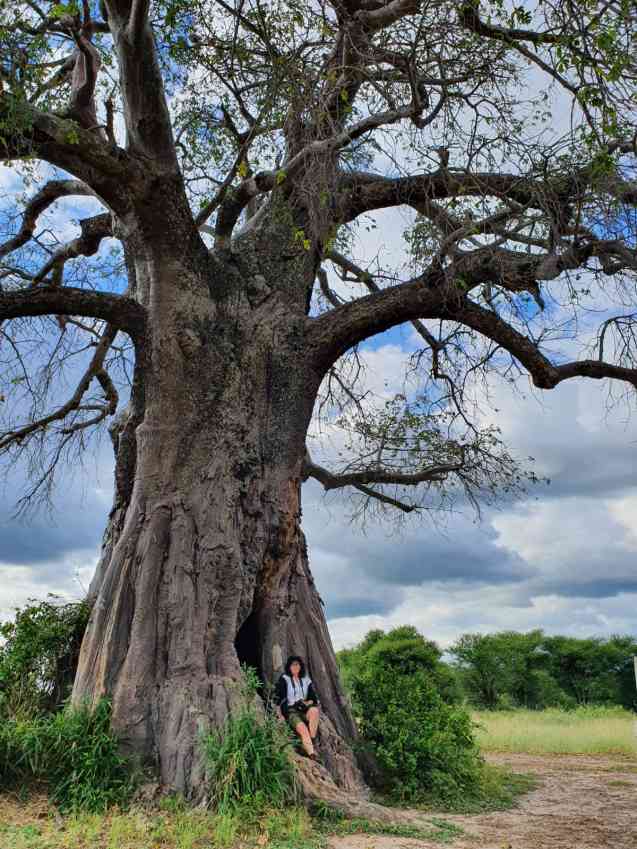 Massive baobab in Tanzania
Massive baobab in Tanzania
Max explained that poachers would bring their catch/es to this tree and hang them inside on iron hooks (which are still there) wait a day or 2 to ensure they hadn’t been followed then collect them. Gladly, this is no longer the case as rangers are constantly patrolling and monitoring the park.
 Inside baobab tree, near Tarangire
Inside baobab tree, near Tarangire
However, the stench of strong lion urine hangs in the air inside the tree and we were shown paw print of lion and leopard into and out of the hollow and a lion’s bed just outside the entrance. It didn’t take much encouragement for us to quickly return to the safety of the vehicle.
 Lion bed at baobab tree, Tarangire area
Lion bed at baobab tree, Tarangire area
We soon discovered that mosquitoes are not a problem when travelling in a safari vehicle with the roof lifted. The wind blows your hair and you are able to easily capture pictures without window reflection, but… don’t underestimate the tenacity of tsetse flies. They wanted to take every opportunity to feast on human blood. It was like they feared another Covid lockdown and no visitors, very much like us South African’s fear liquor/bottle store closures and feverishly rush out to buy for in case. They flew into the moving vehicle, and stayed in, biting through our clothing or any bare exposed fleshed and I’m damn sure I saw them wearing gas masks because they were relentless, even after we had covered ourselves in tabard and Max had sprayed us and the vehicle with serious repellent.
It was nearly nightfall as we headed out of the park to our accommodation for the night. None of the parks is fenced. Sangaiwe Tented Lodge is on a side of a koppie, looking over a flat plain and Lake Burunge.
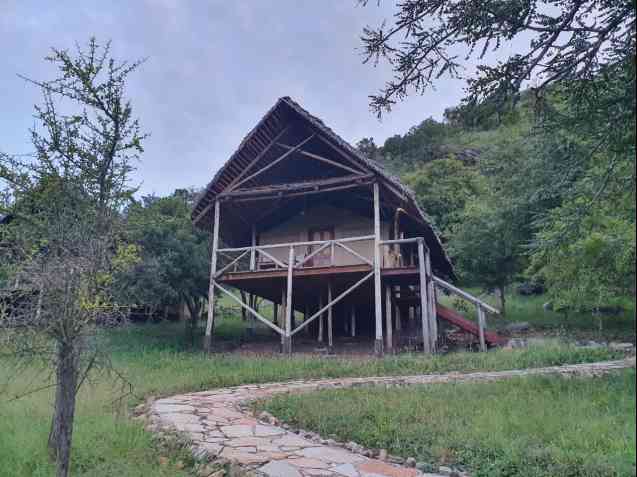 Tented Lodge near Tarangire National Park
Tented Lodge near Tarangire National Park
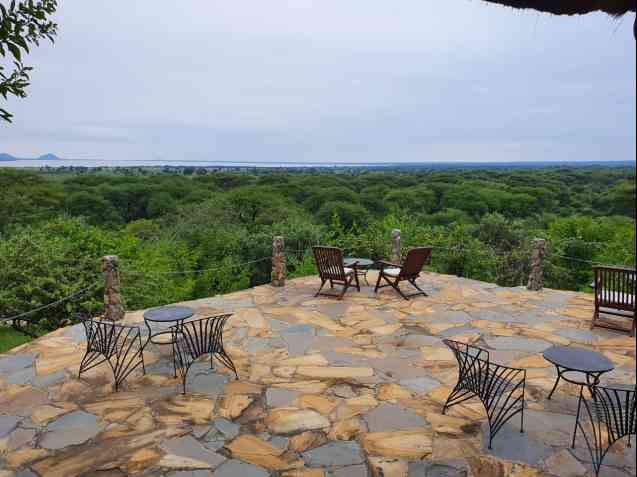 Tented lodge setting
Tented lodge setting
Like all accommodation in Rwanda and Tanzania, you are welcomed by staff with refreshments. In this case baobab juice. We were warned not to walk around alone as all animals wander between the tented rooms and the main living area. Armed staff are called to escort you around when moving between tents and main buildings. The rooms are luxurious.
 Tarangire tented lodge room
Tarangire tented lodge room
We immediately settled in and ordered Kilimanjaro beers and put our feet up to absorb the view.
 Tented lodge view of Lake Burunge
Tented lodge view of Lake Burunge
The food was superb and fresh and you can’t help wondering about the operational logistics of managing some of these remote places.
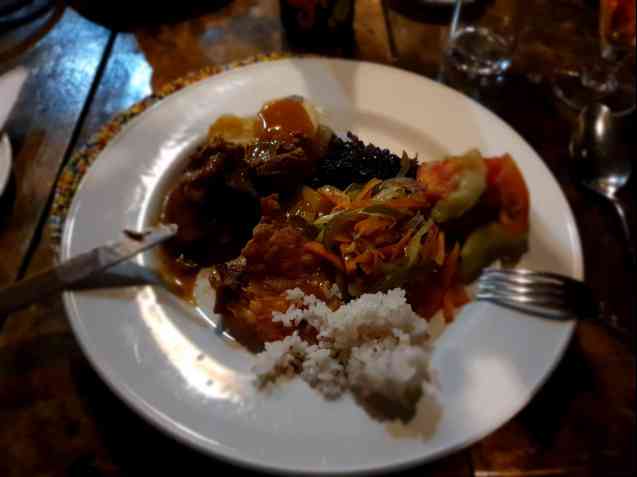 Tented lodge food, Tanzania
Tented lodge food, Tanzania
Maasai Culture of Tanzania
The next morning saw us heading off towards Serengeti. We passed through small towns and villages and the countryside quickly turned rural as we entered the Maasai territory. You can see them for kilometres. Tanzania encourages them to maintain their culture. Their bright shukas (Maasai blankets) stand out as the men sit around discussing “stories” and tending to their stock (in some cases 200 goats and 100 head of cattle) which mingle with wildlife i.e. wildebeest and zebra.
 Maasai in traditional dress, Tanzania
Maasai in traditional dress, Tanzania
The government have stopped only one cultural item and that is for a young man to graduate to manhood by killing a lion. They encourage them to show manhood by taking a few wives and increasing their livestock numbers. A homestead indicates the number of wives by the number of round mud/grass structures that surround the main central and large mud/grass home (the man’s) in the homestead.
 Maasai village, Tanzania
Maasai village, Tanzania
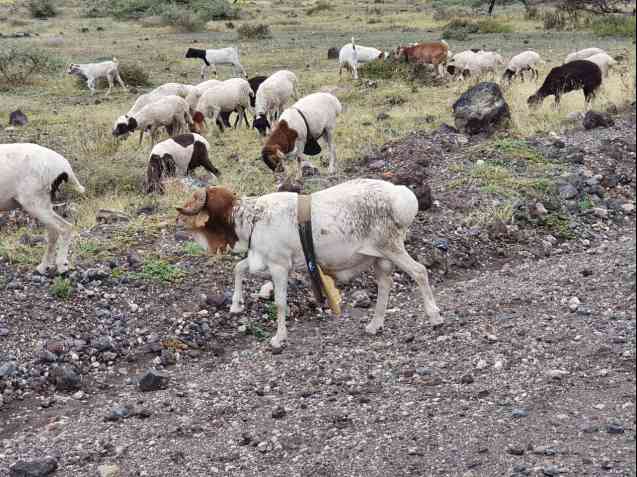 Maasai goat herd
Maasai goat herd
The women tend the homes and do everything else. As the man takes on another wife, the wife/wives preceding her build her mud/grass home. Men wear red shukas until they are committed to a woman (or women) and then they may wear other colours. Their staple diet is meat and milk and out of the blue, you’ll see some young women selling honey and honey wine on very remote roads. They make their own beaded jewellery worn around their necks and both men and women wear long ornate beaded and shiny earrings.
We had a picnic lunch under a tree in the middle of somewhere and nowhere in Maasai land.
 Lunch stop in Serengeti, Tanzania
Lunch stop in Serengeti, Tanzania
Max made plunger coffee (every picnic lunch included Max’s plunger coffee which became something we all looked forward to the entire trip) and he set the bonnet of the vehicle by using a red Maasai shuka, for a tablecloth and served our lunch.
 Tour guide Max making coffee
Tour guide Max making coffee
And as the temperature had dropped we were each given a shuka to wear. They are incredibly warm, and we landed up reaching for them on numerous occasions in the days that followed.
 Serengeti Safari lunchstop
Serengeti Safari lunchstop
Gems of Tanzania, near Ngorongoro Conservation Area
As we approached the Ngorongoro Conservation Area, Max asked whether we had heard about Tanzanite. What?! Which girl hasn’t dreamt or heard of gems, jewels, superman and Tanzanite? He pointed out the mountains/hills in the distance which are prohibited areas being mined and very soon thereafter pulled up at a lush building.
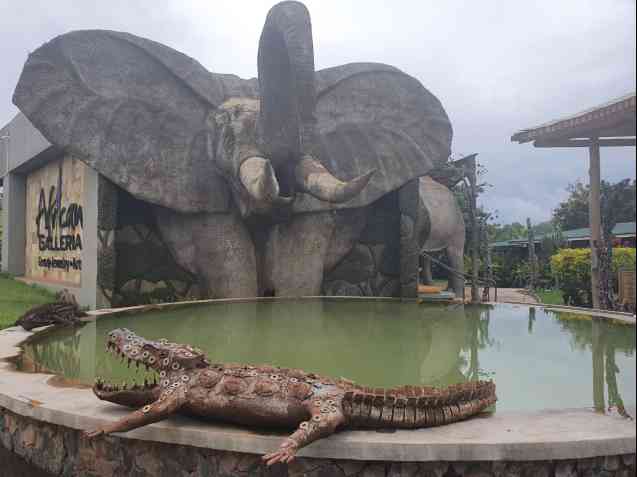 Art shop gallery near Ngorongoro
Art shop gallery near Ngorongoro
Africa Galleria – “Gems – Jewelry – Art”, is perfectly located for visitors near the entrances of Lake Manyara Park and the Ngorongoro Conservation Area.
They have beautiful pieces of tanzanite set in gold or silver or just as is, cut and polished. There were lots of gorgeous pieces which had my name written all over them, which sadly I had to leave behind as my dollars were already committed… But next time… my dollars will travel with the sole purpose of returning with at least a few of these treasures. They have many interesting wares and cater for everyone’s taste. We certainly didn’t leave empty-handed though and amongst my purchases was a dedicated blue shuka to wrap firmly around my husband, Nicholas when I got home. As I got into the vehicle Max had a twinkle in his eye and casually said “Awww, you got a blue one to wrap tightly around his neck,…

